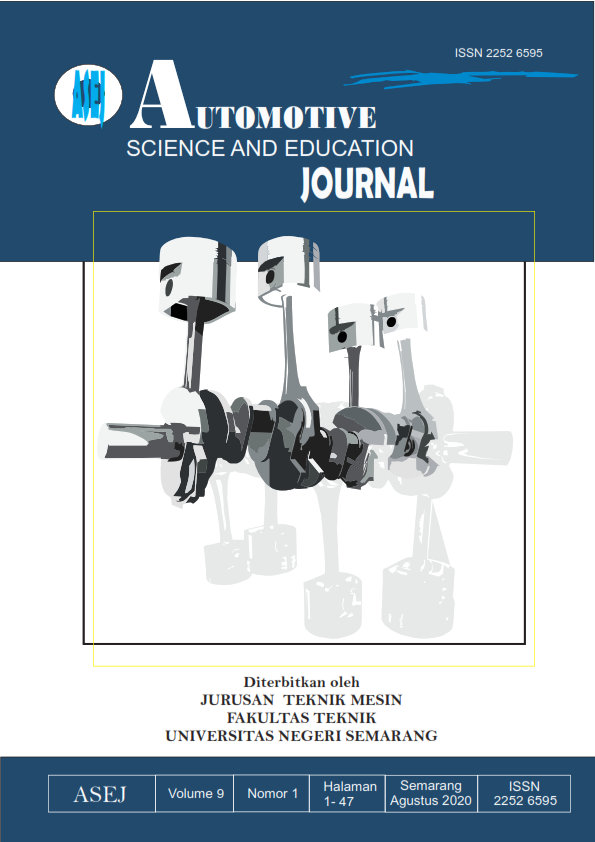Pengaruh Jumlah Pegas Kopling terhadap Torsi dan Daya Sepeda Motor Supra X 100 cc
Main Article Content
Abstract
Performa mesin yang standar dirasa kurang maksimal sehingga menambah jumlah dan kekerasan pegas kopling yang lebih tinggi menjadi pilihan. Kampas kopling dan plat kopling dapat ditekan lebih sempurna dan penyaluran tenaga lebih maksimal. Penelitian ini bertujuan untuk mengetahui perbedaan torsi dan daya yang dihasilkan penggunaan 4 pegas kopling standar dengan 4 pegas kopling racing dan penggunaan 6 pegas kopling standar dengan 6 pegas kopling racing pada sepeda motor. Metode penelitian ini menggunakan eksperimen dan teknik analisis data menggunakan analisis statistik deskriptif. Variabel bebasnya adalah pegas kopling, yaitu: jumlahnya 4 dan 6 pegas serta pegas standar dan racing, sedangkan variabel terikatnya adalah torsi dan daya. Variabel kontrolnya yaitu 2000 sampai 8000 rpm dengan kelipatan 1000 rpm. Hasil penelitian menunjukkan bahwa penggunaan 4 pegas kopling racing menghasilkan torsi tertinggi 7.85 Nm dan daya tertinggi 4.6 kW, lebih baik dari penggunaan 4 pegas kopling standar yang menghasilkan torsi tertinggi 7.72 Nm dan daya tertinggi 4.4 kW. Penggunaan 6 pegas kopling racing menghasilkan torsi tertinggi 8.35 Nm dan daya tertinggi 4.7 kW, lebih baik dari penggunaan 6 pegas kopling standar yang menghasilkan torsi tertinggi 7.92 Nm dan daya tertinggi 4.6 kW. Berdasarkan hasil pengujian tersebut dapat disimpulkan bahwa jumlah dan kekerasan pegas kopling dapat meningkatkan torsi dan daya pada sepeda motor.
Kata kunci : pegas kopling, racing, torsi, daya.
Abstract
The standard engine performance is deemed to be less than optimal so increasing the number of clutch springs and higher hardness is an option. Clutch canvases and clutch plates can be pressed more perfectly and more maximum power distribution. This study aims to determine the difference in torque and power generated using the use of 4 standard clutch springs with 4 clutch clutch springs and the use of 6 standard clutch springs with 6 clutch clutch springs on a motorcycle. This research method uses experiments and data analysis techniques use descriptive statistical analysis. The independent variables are the clutch springs, namely: the number is 4 and 6 springs and standard springs and racing, while the dependent variables are torque and power. The control variables are 2000 to 8000 rpm with multiples of 1000 rpm. The results showed that the use of 4 racing clutch springs produced the highest torque of 7.85 Nm and the highest power of 4.6 kW, better than the use of 4 standard clutch springs that produced the highest torque of 7.72 Nm and the highest power of 4.4 kW. The use of 6 racing clutch springs produces the highest torque of 8.35 Nm and the highest power of 4.7 kW, better than the use of a standard 6 clutch spring that produces the highest torque of 7.92 Nm and the highest power of 4.6 kW. Based on the results of these tests it can be concluded that the number and hardness of the clutch springs can increase torque and power on a motorcycle.
Keyword : Clutch Spring, Racing, Torque,Power
Article Details
Proposed Creative Commons Copyright Notices
1. Proposed Policy for Journals That Offer Open Access
Authors who publish with this journal agree to the following terms:
- Authors retain copyright and grant the journal right of first publication with the work simultaneously licensed under a Creative Commons Attribution License that allows others to share the work with an acknowledgement of the work's authorship and initial publication in this journal.
- Authors are able to enter into separate, additional contractual arrangements for the non-exclusive distribution of the journal's published version of the work (e.g., post it to an institutional repository or publish it in a book), with an acknowledgement of its initial publication in this journal.
- Authors are permitted and encouraged to post their work online (e.g., in institutional repositories or on their website) prior to and during the submission process, as it can lead to productive exchanges, as well as earlier and greater citation of published work (See The Effect of Open Access).
Proposed Policy for Journals That Offer Delayed Open Access
Authors who publish with this journal agree to the following terms:
- Authors retain copyright and grant the journal right of first publication, with the work [SPECIFY PERIOD OF TIME] after publication simultaneously licensed under a Creative Commons Attribution License that allows others to share the work with an acknowledgement of the work's authorship and initial publication in this journal.
- Authors are able to enter into separate, additional contractual arrangements for the non-exclusive distribution of the journal's published version of the work (e.g., post it to an institutional repository or publish it in a book), with an acknowledgement of its initial publication in this journal.
- Authors are permitted and encouraged to post their work online (e.g., in institutional repositories or on their website) prior to and during the submission process, as it can lead to productive exchanges, as well as earlier and greater citation of published work (See The Effect of Open Access).
